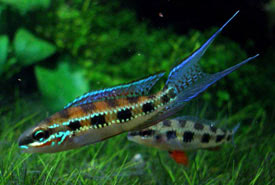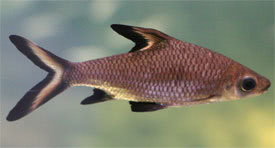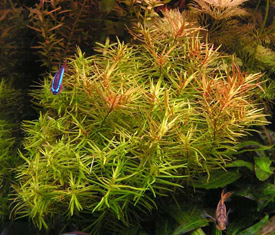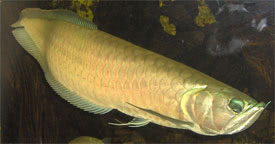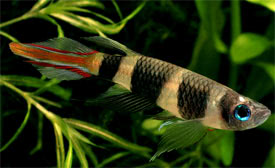
 Magyarul / Hungarian
Magyarul / Hungarian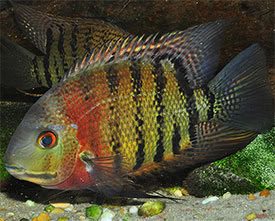
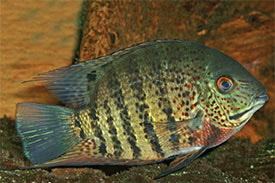
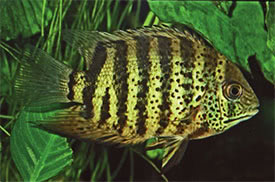

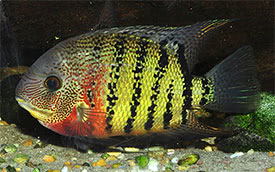
- Scientific name: Heros severus
- Synonyms: Cichlasoma severum (Heckel, 1840)
- Common name: Banded cichlid
- Group: Cichlids
- Distribution: South America; Colombia, Venezuela: Orinoco River basin; Brazil: Amazon River basin, Rio Negro basin
- Size: 15-20 cm
- Biotope: Found in extremely acidic blackwater habitats with very low pH and conductivity.
- Social behavior: A territorial, but fairly peaceful cichlid. They can be kept with other larger peaceful cichlids, but they may eat the small fishes.
- Diet: Omnivorous; In nature they eat plants, algae, and insects, while in aquarium they will take all kinds of live, frozen and dried foods. Occassionally give them some peas or zucchini.
- Breeding: Quite easy
- Tank: Minimum 250 litres
- Population: 1 pair for 350 litres
- Decoration: Prefers a densely planted aquarium with rocks and roots that make some hiding places for the fish. Also place some flat rocks to the tank that the fish can use as spawning sites. Use small gravel or sandy bottom.
- Temperature: 23-29 °C
- pH: 5.0-6.5
- Hardness: 4.0-15.0 dGH
- Lifespan: 10-10 years
Males have more pointed anal and dorsal fins. The females have only a few blue markings on the head and gill cover, or entirely lack these markings, and they are also smaller than males.
If we want to breed them, the best method is to buy a small group, and let them pair up. For optimal breeding conditions maintain the water at a total hardness of 2-6 dGH° with low pH and a temperature between 27-30° C to increase the egg's hatching rate. The male will darken and intensify its colors during courtship and breeding. The female will lay the eggs on previously cleaned flat surfaces. Both parents take care of the eggs and the fry. The number of the eggs is usually 200, but larger females can lay up to 1000 eggs at a time. The eggs hatch in 2-4 days and the larvae become free-swimming after another 3-4 days. Usually the female takes care of the fry, while the male defends the territory. They can be fed with small live foods or powdered flake foods. The parents will care for them for up to 6 weeks.
https://www.fishbase.de/summary/3617
https://en.wikipedia.org/wiki/Banded_cichlid
http://animal-world.com/encyclo/fresh/cichlid/GoldenSeverum.php
https://www.researchgate.net/publication/307974258_Description_of_a_new_Heros_species_Teleostei_Cichlidae_from_the_Rio_Orinoco_drainage_and_notes_on_Heros_severus_Heckel_1840





















